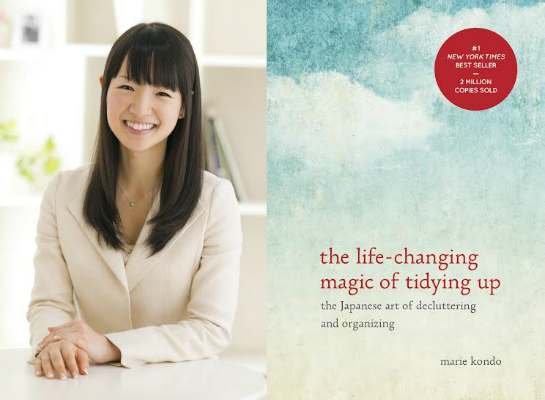This is a followup to my first Marie Kondo post, and is meant to serve as a thought-dump of what I took from the book, and how it has affected my life. I am well aware of the risks of sounding vaguely faddish — like people that can’t stop talking about their cross-fit classes or that new vegan diet that has changed everything and why you should take them up too, because life is meaningless otherwise, darling.
Uh-huh. The context here is that I have, for a while, been wondering about specific things regarding my lifestyle. The only thing that moved with me to LA from India, were my collection of books. These are books that have (mostly) been bought from 2002 onwards, ever since I graduated from college, and have moved with me from apartment to apartment, city to city. The ones bought before 2002? Most were transferred to my parents’ place in Assam. A lot of those have ended up in the library in my mother’s school, or have gone to her students who seemed interested in reading.
Over the last few years, I have been curating the books that stay on my shelves, which is to say that the ones on display in the living room are the ones that I *love* to own. Now a bulk of these books are comics and manga, and while I have quirks related to those (case in point: at one point, Watchmen was present in my shelves as the original 12 issues, a trade paperback, a 10th anniversary trade paperback, and an Absolute Edition. Right now, I just have the Absolute Edition and the original 12 issues), the comics get read and reread frequently. I cleared out a couple of shelves before moving to LA, and last year, a chunk of comics that I never read went to the local comic-book store. But despite my occasional cleanup, I still had way too many books. And the sad thing is — it’s not like I reread any of them. They were all just there, as a function of my taste and what was available in bookstores in the last decade. You have to remember, that was a time when e-readers did not exist, and neither did Flipkart or Amazon. If I saw a book at a used bookstore and did not pounce on it, I had no idea if I would ever see it again. So yeah, I bought everything, because I was earning enough and I could. My buying habits changed over the years, and it’s no longer about going nuts during a discount sale or bidding on random deals on eBay,
The best thing of Marie Kondo, in my opinion, is that she does not talk of minimalism — which right now is an -ism that encourages a competitive zeal in lowering the number of possessions you own. Ms Kondo’s techniques help enable a certain kind of mental freedom in evaluating your possessions. You do not need to disown everything, she says. All you have to do is to find the things that bring you joy. Which meant that the question she asked was not “what do you want to throw away?”, it was “what do you want to keep?”
One fine day last week, I did what the KonMari method prescribed. Which is to tackle one kind of item at a time — in this case, books — and piling them all in one place; and without being distracted, to sort them one by one into two categories: the ones that spark joy and the ones that don’t. At first, I was too lenient. Of course, I loved my Terry Pratchett paperbacks, and the Tom Sharpes, and the Robert Heinleins and the Andrew Vachsses. They were not getting out of my sight. Why on earth would I want to get rid of my Harry Potter first edition hardcovers? Or the Kamala Subramanium Mahabharata and Bhagavata Purana that I bought so many years ago? Those books were memories for me, and it seemed criminal to get rid of them.
Except, if I took away my projected feelings for them, they were just semi-yellowed, well-thumbed blocks of paper, most of which hadn’t been opened in years. My Stephen King Dark Tower books were still waiting to be read since 2005 or thereabouts. The Richard Burton Arabian Nights volume, pretty as it was, had never been opened in the United States. I reread some Vachss and some Pratchetts every now and then. But not the books I owned; I would just download them on my Kindle when I wanted. The more I thought about it, the more I realized the books weren’t really bringing much of value to my life, they were more fetish objects than the ideas they represented. Once that switch flipped in my head, it became easier and easier to understand what I should keep, and what should go.
I ended up with 9 boxes of books that I no longer wanted, after 2 nights of sorting. I took them all to the local charity shop. The books that still remain fit one shelf; there is another shelf that I will refer to as a ‘probation area’; I have left the books that I may put up on eBay, or give away as gifts, or are novel enough to merit their presence. I could not get rid of the first edition of Gods, Demons and Others, as much as I thought I would; nor could I let the Diana Wynne-Joneses go. But I have given myself 3 months – if the books on the probation area still remain untouched and unread, they all go.
One might think that there is an addendum where I reminiscence about the emptiness the missing books have left in my life, but on the contrary, I feel happy. And free, in a way. Is that a two-thumbs-up vote for the KonMari method? I guess. I still feel like I cheated because I did not do anything about my comics, but you know, I am okay with that. My comics have always sparked joy in my life.
In addition to what I did above (and I did that with my clothes a few weeks ago, which was easier), I have been doing specific things that Ms Kondo recommends in her book.
- The most important thing is that of mentally assigning things in their right place, at home. She advocates figuring out where every item you own belongs, so that the amount of clutter is minimized, and also you think more about where something new should go, when you think of buying it.
- Clearing the space around the kitchen sink, the bathroom shower and wash basin. It helps a lot, both in terms of aesthetics and mental calm.
- Folding my clothes the right way and stacking them horizontally, not vertically; that’s one of the smartest moves ever. I did that with everything, including socks, underwear, hand towels, pocket squares and t-shirts, and it really serves its purpose well.
- In general, using the ‘spark joy’ method is a great way to figure out if you want to do something, anything at all. An invite to a dinner party? A choice between reading this book or that book or not reading either of them? If it’s not making me happy, why should I be doing it all?

